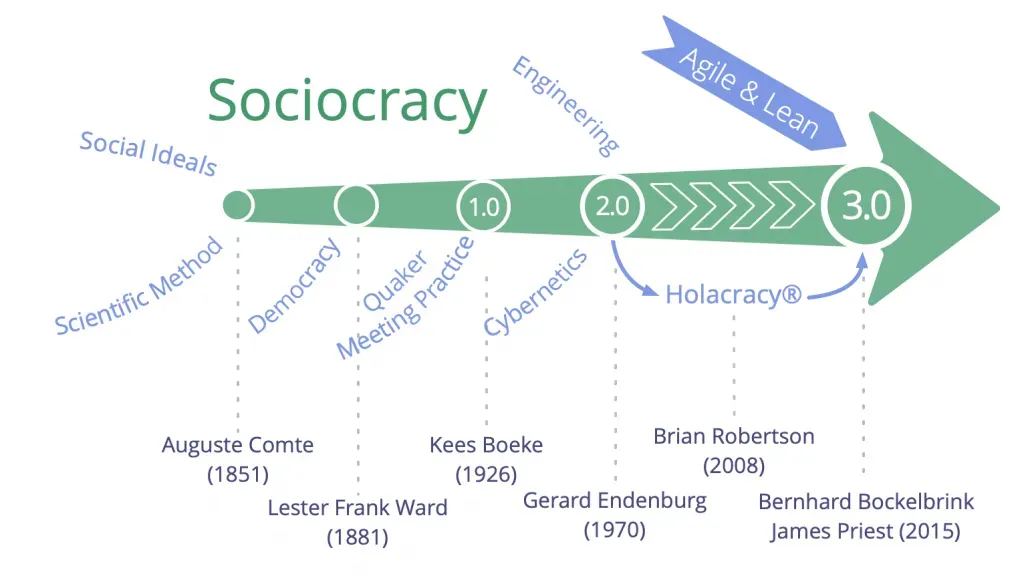Sociocracy Overview
A practical guide to collaborative governance
This governance system, designed to foster collaboration, equality, and efficiency, offers a practical framework for organizations seeking more effective ways to work together.

In an era where traditional hierarchical structures often struggle to meet modern organizational challenges, sociocracy emerges as a powerful alternative. This governance system, designed to foster collaboration, equality, and efficiency, offers a practical framework for organizations seeking more effective ways to work together.
What Is Sociocracy?
Sociocracy is a governance system that enables organizations to self-organize while maintaining clear direction and structure. It combines the best aspects of top-down and bottom-up approaches, creating a flexible yet robust framework for decision-making and operations.
The word “sociocracy” means “rule by the socios” – people who have a social relationship with each other. This hints at its fundamental principle: those affected by decisions should have a voice in making them.
Core Principles
1. Consent Decision-Making
Unlike consensus where everyone must agree, consent means no one has a reasoned, paramount objection. This subtle but crucial difference enables both thorough consideration and efficient progress. Decisions are made when:
- All participants understand the proposal
- No one identifies a risk that could harm the organization
- Everyone can work with the decision, even if they might prefer alternatives
2. Circle Structure
The organization operates through semi-autonomous circles (groups), each responsible for specific domains:
- Each circle has clear aims and accountabilities
- Circles have authority to make decisions within their domain
- Members participate in multiple circles based on their roles
- Circles can create sub-circles for specific functions
3. Double-Linking
Circles connect through a system of double links, ensuring robust communication and alignment:
- An operational leader from the higher circle
- A representative elected by the circle members
- Both participate fully in both circles’ decision-making
- This creates redundancy in information flow and feedback
4. Selection by Consent
Rather than traditional voting or top-down appointments:
- Roles are filled through open discussion
- Candidates are selected based on qualifications
- The group consents to selections
- Regular evaluation and term limits ensure adaptability
Practical Implementation
Setting Up Circle Structure
-
General Circle
- Holds the organization’s overall purpose
- Sets strategic direction
- Contains representatives from all primary circles
-
Primary Circles
- Focus on major functional areas
- Develop policies and procedures
- Manage operations within their domain
-
Sub-Circles
- Handle specific tasks or projects
- Report to primary circles
- Can be temporary or permanent
Essential Roles
Every circle typically includes:
- Facilitator: Guides meetings and decision-making processes
- Secretary: Manages records and scheduling
- Leader: Oversees operations and represents higher circles
- Representative: Represents the circle in higher-level decisions
Meeting Structure
Sociocratic meetings follow a clear format:
- Opening Round: Check-in and agenda confirmation
- Administrative: Minutes, announcements, metrics
- Agenda Items: Using consent decision-making
- Closing Round: Feedback and evaluation
Benefits and Challenges
Benefits
- Clear decision-making processes
- Distributed authority and responsibility
- Enhanced engagement and ownership
- Improved communication flow
- Flexibility to adapt and evolve
Common Challenges
- Initial learning curve
- Need for training and practice
- Resistance to change
- Time investment in meetings
- Maintaining discipline in processes
Best Practices for Success
-
Start Small
- Begin with one circle or team
- Practice basic processes first
- Expand gradually based on learning
-
Invest in Training
- Ensure all participants understand the basics
- Regular refresh sessions
- Document and share learning
-
Regular Evaluation
- Review circle effectiveness
- Assess decision outcomes
- Adapt processes as needed
-
Clear Documentation
- Record decisions and rationale
- Maintain accessible policies
- Track circle boundaries and responsibilities
Steps to Implement Sociocracy for a New Project
- Define the Purpose: Clearly articulate the project’s mission, goals, and vision to align participants on a shared objective.
- Form Initial Circles: Identify key areas of responsibility (e.g., planning, execution, communication) and form circles for each domain.
- Set Governance Rules: Define the rules for decision-making (e.g., how consent is reached), meeting formats, and communication protocols.
- Assign Roles: Use consent-based selection to assign roles such as facilitator, secretary, and circle representatives.
- Run Meetings: Hold regular circle meetings to discuss progress, address issues, and make policy decisions using the consent process.
- Double-Linking: Establish connections between circles through representatives who participate in both their circle and the overarching governance circle.
- Evaluate and Iterate: Periodically review processes, adapt roles, and improve collaboration based on feedback and changing needs.
Conclusion
Sociocracy offers a structured yet flexible approach to collaborative governance. While it requires investment in learning and practice, its principles provide a robust framework for organizations seeking more effective ways to work together. The key to success lies in understanding its core principles, starting small, and maintaining commitment to the process as the organization grows and evolves.
The beauty of sociocracy lies in its adaptability – organizations can modify its implementation while maintaining its essential principles. As more organizations face the challenges of rapid change and complex decision-making, sociocracy provides a tested framework for creating more resilient, adaptive, and human-centered organizations.
My Adaptations
- Vision Circle: Slightly different from the General Circle. It’s not composed of representatives of all primary circles, but of pure guardians of the overarching vision.
- Single-Linking: A single representative acts as the sole point of contact with other circles. (Can change back to double-linking if needed.)
⚠️ These representatives must have a strong understanding of their circle’s activities, decisions, and challenges to effectively communicate and align with others. - Standup Meetings for Representatives: Regular short meetings (usually weekly) to share updates and maintain a high-level understanding across all circles.
- Vision Meetings: Held by the Vision Circle. All representatives participate mainly as passive observers, unless something critical from their circle must be heard.